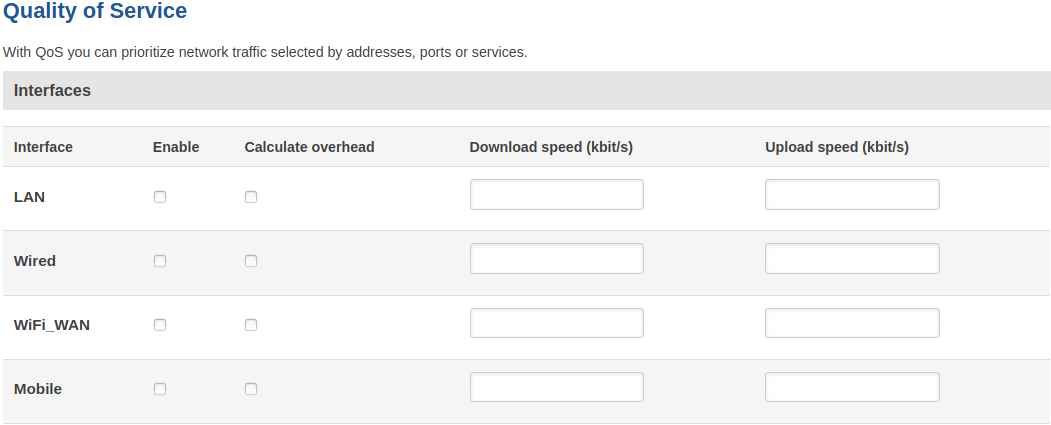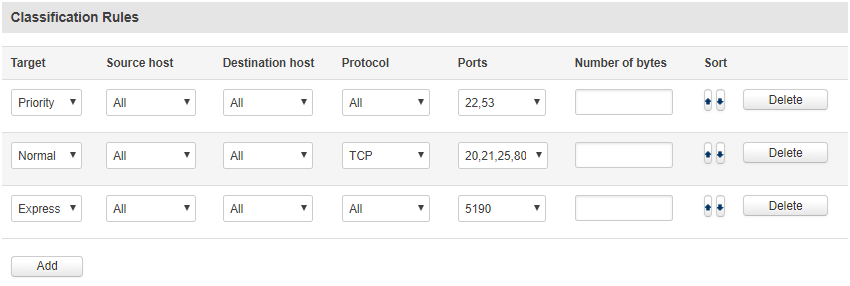RUT950 QoS (legacy WebUI): Difference between revisions
(Created page with "{{Template: Networking_rut_manual_qos_legacy <!------------------------DEVICE-----------------------> | name = RUT950 | series = RUT9XX }}") |
m (Dziugas moved page Draft:RUT950 QoS (legacy WebUI) to RUT950 QoS (legacy WebUI) without leaving a redirect) |
(No difference)
| |
Latest revision as of 14:01, 19 July 2021
Main Page > EOL Products > RUT950 > RUT950 Manual > RUT950 Legacy WebUI > RUT950 Services section (legacy) > RUT950 QoS (legacy WebUI)The information in this page is updated in accordance with firmware version RUT9XX_R_00.06.09.5.
Note: this user manual page is for RUT950's old WebUI style available in earlier FW versions. Click here for information based on the latest FW version.
Summary
QoS provides the possibility to prioritize network traffic based on hosts, ports or services and limit download & upload speeds on a selected interface.
This chapter of the user manual provides an overview of the QoS page in RUT950 devices.
Interfaces
The Interfaces section is used to set up download and upload speed limits on the device's network interfaces.
| Field | Value | Description |
|---|---|---|
| Interface | WAN | LAN | WiFi_WAN | Mobile | Interface to which the rule applies. |
| Enable | yes | no; default: no | Turns the rule on or off. |
| Calculate overhead | yes | no; default: no | Decreases upload and download ratio to prevent link saturation. |
| Download speed (kbit/s) | integer; default: none | Maximum download speed for the specified interface. |
| Upload speed (kbit/s) | integer; default: none | Maximum upload speed for the specified interface. |
Classification Rules
The Classification Rules section is used to configure rules that prioritize certain traffic over other, less important traffic. This traffic can be defined by a source or destination host, port or a network protocol. Traffic that matches a rule with higher preference will be handled with higher priority.
Generally, this should be used in cases where you want to isolate certain types of traffic in order to make sure the RUT950 is handling more important traffic (for example, video streaming, SSH) at a higher priority and less important traffic (FTP, HTTP) at a lower priority.
| Field | Value | Description |
|---|---|---|
| Target | Priority | Express | Normal | Low; default: Normal | Defines the priority of handling the type of traffic defined in this rule. |
| Source host | All | IP; default: All | Host(s) from which data will be transmitted. |
| Destination host | All | IP; default: All | Host(s) to which data will be transmitted. |
| Protocol | All | TCP | UDP | ICMP | -- custom --; default: All | Data transmission protocol to match the rule. |
| Ports | All | integer [0..65535]; default: none | Port number(s) to match the rule. You can enter multiple ports by separating them by commas (e.g., 22,53,80). |
| Number of bytes | integer; default: none | Maximum number of bytes for this connection. |


